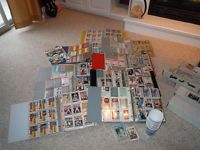Lists - It's one of those things everyone does, you see everywhere and yet everyone hates doing them. Let's look at some explanations of the typical lists you'll see at your local card shows.
Traditional
This means everything from your notepad with items scribbled down on it to your neatly sectioned binders with meticulously planned line by line listings. You can't go wrong with the old tried and true by any means. That said, you may not exactly do very well with scribbled, loose pages either. Best advice I can give you is to keep reasonably detailed lists and organize them so they are easy to reference.. Try to avoid adding multiple sets to the same page - I highly recommend adding your want list cards for each set on their own page. Then take those pages and store them by year/set for easy reference at a show.
Electronic
Given the useability of smartphones, laptops and tablets, this is the next generation of list making for the hobbyist.Lists can be as simple as a Wordpad listing of missing cards to a detailed MS Access database which allows you to print off base on team, player, year, set, etc.
I am seeing more and more people at shows walking around with a tablet to find that missing card and while I am new to using this myself, I find there are huge advantages to having an electronic list.
Ultimately the best advice I can give you with list making is to take the avenue that is best for you and your interests and allows you to easily find missing cards. Nothing is worse than thumbing around at someone's booth for 5 minutes to figure out if you need cards from a particular set or if the vendor has what your looking for. Nothing can help in a hobby like card collecting like organization and easy to access lists.
Traditional
This means everything from your notepad with items scribbled down on it to your neatly sectioned binders with meticulously planned line by line listings. You can't go wrong with the old tried and true by any means. That said, you may not exactly do very well with scribbled, loose pages either. Best advice I can give you is to keep reasonably detailed lists and organize them so they are easy to reference.. Try to avoid adding multiple sets to the same page - I highly recommend adding your want list cards for each set on their own page. Then take those pages and store them by year/set for easy reference at a show.
Electronic
Given the useability of smartphones, laptops and tablets, this is the next generation of list making for the hobbyist.Lists can be as simple as a Wordpad listing of missing cards to a detailed MS Access database which allows you to print off base on team, player, year, set, etc.
I am seeing more and more people at shows walking around with a tablet to find that missing card and while I am new to using this myself, I find there are huge advantages to having an electronic list.
Ultimately the best advice I can give you with list making is to take the avenue that is best for you and your interests and allows you to easily find missing cards. Nothing is worse than thumbing around at someone's booth for 5 minutes to figure out if you need cards from a particular set or if the vendor has what your looking for. Nothing can help in a hobby like card collecting like organization and easy to access lists.

 RSS Feed
RSS Feed